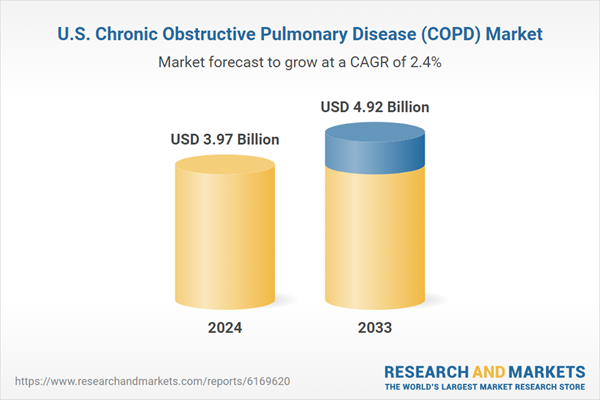United States Chronic Obstructive Pulmonary Disease (COPD) Market Report: 2025-2033
Executive Summary
The United States Chronic Obstructive Pulmonary Disease (COPD) market was valued at US$ 3.97 billion in 2024 and is projected to reach US$ 4.92 billion by 2033, expanding at a Compound Annual Growth Rate (CAGR) of 2.42% from 2025 to 2033. This growth is influenced by demographic shifts, environmental factors, and technological advancements. The market’s dynamics are intrinsically linked to several United Nations Sustainable Development Goals (SDGs), particularly those concerning health, inequality, and innovation.
Alignment with Sustainable Development Goals (SDGs)
SDG 3: Good Health and Well-being
The COPD market directly addresses SDG 3 by focusing on a major non-communicable disease that is a leading cause of morbidity and mortality in the United States. Efforts to improve diagnosis, treatment, and long-term care contribute to reducing premature mortality. Innovations in pharmaceutical interventions, such as improved inhalers (LAMA/LABA, triple therapy) and biologics (DUPIXENT, NUCALA), alongside pulmonary rehabilitation and oxygen therapy, are critical to enhancing the quality of life and well-being for millions of Americans affected by COPD.
SDG 10: Reduced Inequalities
Significant challenges within the COPD market highlight disparities that contravene SDG 10. The report notes that COPD disproportionately affects low-income populations and individuals in rural states like Kentucky, West Virginia, and Mississippi. High treatment costs and limited access to specialized healthcare create significant inequalities. Addressing these issues through government programs, telehealth expansion, and public-private partnerships is essential for ensuring equitable access to quality medical care for all, regardless of geographic location or socioeconomic status.
SDG 9: Industry, Innovation, and Infrastructure
The market’s growth is propelled by advancements aligned with SDG 9.
- Pharmaceutical Innovation: Investment in biologics, next-generation inhalation devices (e.g., soft mist and breath-actuated inhalers), and dual PDE3/4 inhibitors like OHTUVAYRE represents significant progress in industrial research and development.
- Digital Health Infrastructure: The expansion of telehealth services, remote monitoring devices, and mobile applications for patient management is enhancing healthcare infrastructure, making care more accessible and efficient, particularly following the COVID-19 pandemic.
SDG 11: Sustainable Cities and Communities
The report identifies environmental factors, including long-term exposure to air pollution, as a primary driver of COPD. This directly connects the prevalence of the disease to the objectives of SDG 11, which aims to make human settlements safe, resilient, and sustainable. Reducing air pollution is a critical public health strategy for preventing new cases of COPD and mitigating its severity.
SDG 8: Decent Work and Economic Growth
Occupational exposure to dust and chemicals is cited as a significant risk factor for COPD. This underscores the importance of SDG 8’s focus on promoting safe and secure working environments for all workers. Preventing occupational respiratory diseases is crucial for maintaining a healthy workforce and achieving sustainable economic growth.
Market Growth Drivers
- Aging Population and Disease Prevalence: The U.S. Census Bureau projects a near doubling of the population aged 65 and older by 2060. As lung function naturally declines with age, this demographic shift is expected to significantly increase the number of COPD cases, driving demand for treatment and care.
- Therapeutic and Technological Innovation: Continuous advancements in pharmaceuticals, including combination therapies and biologics, are improving symptom management and patient outcomes. Concurrently, innovations in delivery systems and digital health solutions like telehealth are enhancing treatment adherence and accessibility.
- Expansion of Home-Based and Remote Care: The adoption of telehealth and home-based respiratory care models improves access for patients in rural and underserved areas. Remote monitoring and virtual rehabilitation programs are becoming key components of value-based care, reducing hospital readmissions and costs.
Market Challenges
- Delayed Diagnosis and Low Awareness: COPD often goes undiagnosed until it reaches an advanced stage, as early symptoms are commonly mistaken for signs of aging. This underreporting and delayed diagnosis limit treatment effectiveness and increase the risk of severe complications.
- High Costs and Healthcare Disparities: The financial burden of long-term COPD management, including expensive medications and therapies, is a major barrier. Access to care is further limited by geographic and socioeconomic inequalities, particularly affecting low-income and rural populations.
Market Segmentation Analysis
By Type
- Chronic Bronchitis
- Emphysema
By Treatment
- Drugs
- Oxygen Therapy
- Surgery
- Others
By Distribution Channel
- Hospital Pharmacies
- Retail Pharmacies
- Online Pharmacies
Key Companies Profiled
- AstraZeneca
- Pfizer, Inc.
- GlaxoSmithKline plc.
- Novartis AG
- Astellas Pharma Inc.
- Abbott Laboratories
- Boehringer Ingelheim International GmbH
- Almirall
Identified Sustainable Development Goals (SDGs)
The article on the Chronic Obstructive Pulmonary Disease (COPD) market in the United States addresses several SDGs by focusing on public health, technological innovation, environmental health risks, and socioeconomic inequalities in healthcare.
- SDG 3: Good Health and Well-being: This is the most central SDG, as the entire article revolves around COPD, a major non-communicable disease. It discusses the disease’s prevalence, high rates of morbidity and mortality, treatment methods (pharmaceuticals, therapy), and challenges in diagnosis and patient care.
- SDG 9: Industry, Innovation, and Infrastructure: The report highlights the economic and industrial aspects of healthcare. It details significant investment in research and development for new treatments, such as “biologics and next-generation inhalation devices,” and the adoption of “digital health solutions, such as smartphone apps and remote monitoring devices,” which points directly to fostering innovation in the healthcare industry.
- SDG 10: Reduced Inequalities: The article explicitly points out significant inequalities in health outcomes and access to care. It states that “low-income groups are disproportionately affected by COPD” and face barriers like “less access to high-quality medical treatment.” It also mentions geographic disparities, noting challenges for patients in “remote areas” and a “lack of respiratory experts” in rural regions.
- SDG 11: Sustainable Cities and Communities: This goal is connected through the discussion of environmental risk factors. The article identifies “long-term exposure to air pollution” as a major contributor to the COPD burden, linking the health of the population directly to the environmental quality within communities.
Specific SDG Targets
Based on the issues discussed, several specific SDG targets can be identified as directly relevant to the challenges and developments in the US COPD market.
- Target 3.4: By 2030, reduce by one-third premature mortality from non-communicable diseases through prevention and treatment. The article addresses this by focusing on COPD, which it calls “one of the biggest causes of morbidity and death.” The discussion on improved treatments, therapies, and early detection efforts are all aimed at managing this chronic respiratory disease and reducing its mortality rate.
- Target 3.8: Achieve universal health coverage, including financial risk protection, access to quality essential health-care services and access to safe, effective, quality and affordable essential medicines. The article highlights major gaps related to this target, citing “high treatment costs,” “expensive drugs,” and how “low-income groups…may have less access to high-quality medical treatment and prescription drugs” as significant challenges. The expansion of telehealth is noted as a positive step toward improving access.
- Target 3.9: By 2030, substantially reduce the number of deaths and illnesses from hazardous chemicals and air, water and soil pollution and contamination. The article directly links COPD prevalence to environmental factors, stating that “long-term exposure to air pollution” and “occupational exposure to dust and chemicals” greatly increase the disease load.
- Target 9.5: Enhance scientific research, upgrade the technological capabilities of industrial sectors…encouraging innovation. This is reflected in the article’s description of the market’s key drivers, including “innovations in pharmaceuticals and medical devices,” investment in “biologics and next-generation inhalation devices,” and the development of “digital health solutions” to improve patient care.
- Target 10.2: By 2030, empower and promote the social, economic and political inclusion of all, irrespective of…economic or other status. The article highlights the need to work towards this target by identifying existing inequalities, such as how “low-income groups are disproportionately affected by COPD” and how “rural areas” suffer from a “lack of respiratory experts.”
- Target 11.6: By 2030, reduce the adverse per capita environmental impact of cities, including by paying special attention to air quality. The article’s emphasis on “air pollution” as a primary risk factor for COPD underscores the importance of improving air quality in communities to protect public health.
Implied Indicators for Measurement
The article implies several indicators that could be used to track progress towards the identified targets, even if it does not cite official SDG indicator codes.
- Mortality and prevalence rates for chronic respiratory disease: The article’s statements that “millions of Americans suffer from COPD” and that it is a leading “cause of morbidity and death” directly point to using prevalence and mortality statistics as key indicators for Target 3.4.
- Healthcare access and cost metrics: Indicators of progress for Target 3.8 are implied in the discussion of challenges like “high treatment costs,” “inequalities in access to healthcare,” and the “lack of respiratory experts” in certain areas. Measuring out-of-pocket health expenditures and the availability of specialists by geographic region would be relevant.
- Data on R&D investment and new technology adoption: For Target 9.5, the article implies tracking investment by “biopharmaceutical companies” in new drugs and the rate of adoption of “digital health solutions” like telehealth and remote monitoring devices.
- Health outcomes disaggregated by income and geography: To measure progress on Target 10.2, the article suggests the need for indicators that track the prevalence of COPD and access to care among “low-income groups” and populations in “rural areas” versus other demographics.
- Air pollution levels: The identification of “air pollution” as a major cause of COPD implies that monitoring air quality levels (such as PM2.5 concentrations) is a critical indicator for both Target 3.9 and Target 11.6.
SDGs, Targets and Indicators Analysis
| SDGs | Targets | Indicators Identified or Implied in the Article |
|---|---|---|
| SDG 3: Good Health and Well-being |
|
|
| SDG 9: Industry, Innovation, and Infrastructure |
|
|
| SDG 10: Reduced Inequalities |
|
|
| SDG 11: Sustainable Cities and Communities |
|
|
Source: globenewswire.com







